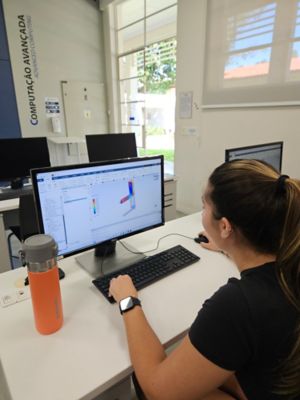
Enabling More Simulation in Less Time
In oil and gas production, the well stream flows through very large, cylindrical separation vessels where, mainly under gravity, it is separated into its constituents. The presence of gas in the production stream from the wellhead generates a three-phase flow, which then needs to be separated into a gas phase for recovery, an oil phase for dehydration and transport, and a water phase for treatment. In some cases, oil and gas platforms produce at only 50% of design capacity due to poor separation, so simulation is critical to improving their efficiency.

Separation vessels are retrofitted with internals to enhance their separation efficiency.
Saudi Aramco Research & Development Center uses Ansys Fluent modeling and simulation
to select the best option among commercially available separator
internals, as well as to design their own proprietary internals. Fluent
is also used to predict the performance of the separator vessels under
varying operation conditions.
Computational fluid dynamics (CFD) has been used to troubleshoot
separation equipment, mainly by analyzing liquids and gasses separately.
Extended use of multiphase simulation is now possible thanks to
enhancements to computing power, as well as the high-performance
computing (HPC) scalability and performance improvements we’ve made to
Ansys Fluent. The multiphase method allows for detailed analysis of
interphase interactions, providing more realistic results than
individual CFD analyses. However, the Euler-Euler multiphase models used
in the simulation are complex and require multiple global
synchronizations, making them harder to efficiently scale at high core
counts than single phase laminar or turbulent flow simulation models.
Unstructured mesh and complex geometry add further to the complexity.

Shaheen II, a 36-cabinet Cray XC40 supercomputer at KAUST
To improve the efficiency of the multiphase simulation runs,
Ansys collaborated with Saudi Aramco and the KAUST Supercomputing Core
Lab (KSL), which runs Shaheen II, a Cray® XC40™ supercomputer to best
our previous record of scaling Ansys Fluent to 36,000 cores.
We are committed to taking simulations to new levels of software
scalability to benefit all of our customers, so the need for strong HPC
technology partnerships is crucial. Software and HPC developers need to
collaborate to ensure the simulation software scales well on the latest
HPC infrastructure. To do so requires a user community to provide
real-world, industrially and/or scientifically relevant applications.
And, because it is often impossible for industrial companies like Saudi
Aramco to divert their production HPC systems to test this level of
extreme scalability, they need an HPC center like KSL to provide access
to large HPC resources and HPC system expertise.
Because separators are used throughout the oil and gas industry to split
production fluids into components of oil, gas and water (as well as
contaminants), the new Ansys HPC scalability milestone will benefit the
entire industry. However, it will also have far-reaching effects beyond
the oil and gas industry, and even beyond other supercomputing users.

HPC partnerships are crucial for reaching new supercomputing heights.
HPC Development Benefits All Users
While
your local workstation or cluster probably doesn’t approach the 6,174
nodes representing 197,568 processor cores in KSL’s Shaheen II
supercomputer, the software development work we do to improve Ansys HPC
scalability still matters to your day-to-day work. The improvements we
make based on our scalability efforts allow you to decrease your time to
solution either by running more models or higher fidelity models on
your current hardware, or by taking advantage of more compute power on
new hardware. Either way, you can solve simulations faster and explore
more — and more advanced — solutions in less time. Ultimately you can
innovate better and faster with HPC-enabled simulations.
That’s why we continue to invest in record-breaking HPC scalability as
part of our Ansys software development. It might not get you a
mustard-colored belt, but saving product development time and enabling
more complex simulation runs are a lot easier on your stomach.
Want to learn more? Check out our white paper: The Value of High-Performance Computing for Simulation



No comments:
Post a Comment